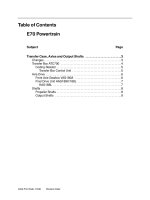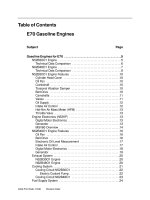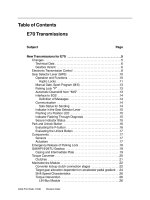C1520 02
Bạn đang xem bản rút gọn của tài liệu. Xem và tải ngay bản đầy đủ của tài liệu tại đây (21.42 KB, 2 trang )
Designation: C 1520 – 02
Standard Guide for
Paintability of Latex Sealants1
This standard is issued under the fixed designation C 1520; the number immediately following the designation indicates the year of
original adoption or, in the case of revision, the year of last revision. A number in parentheses indicates the year of last reapproval. A
superscript epsilon (e) indicates an editorial change since the last revision or reapproval.
1. Scope
1.1 This guide describes the practical considerations that
may be used to determine the compatibility of a paint or
coating to be applied over a latex sealant or caulk. It evaluates
the appearance and not the performance characteristics of the
coated or painted joint.
1.2 The committee with jurisdiction over this standard is not
aware of any comparable standards published by other organizations.
1.3 This standard does not purport to address all of the
safety concerns, if any, associated with its use. It is the
responsibility of the user of this standard to establish appropriate safety and health practices and determine the applicability of regulatory requirements prior to use.
3.3 cracking—a failure resulting in a discontinuous film (of
paint) or bead (of sealant).
2. Referenced Documents
2.1 ASTM Standards:
C 717 Terminology of Building Seals and Sealants2
D 1729 Practice for Visual Evaluation of Color Differences
of Opaque Materials3
D 2244 Test Method for Calculation of Color Differences
from Instrumentally Measured Color Coordinates3
E 284 Terminology of Appearance3
6. Temperature
6.1 Since standard testing is usually performed at “room
temperature,” about 22°C, this would be considered the ideal
temperature for application and curing. As the temperature
deviates from this ideal, the “science” of drying changes in as
much as lower temperature results in slower drying and faster
drying occurs at elevated temperatures.
4. Summary of Practice
4.1 This guide reviews many of the issues concerning the
compatibility of latex sealants with paint. While the focus of
this guide is on latex sealants, the paint or coating may be of
any composition.
5. Significance and Use
5.1 The intent of this guide is to provide the reader with
information concerning possible reasons for paint failures
where the paint is used over a latex sealant.
CONSIDERATIONS
7. Percent Relative Humidity
7.1 In waterborne sealants, the humidity directly affects the
ability of the system to lose water. Standard testing is typically
done at 50 % RH, which allows for an acceptable evaporation
rate. Temperature and humidity variations in climatic regions
and fluctuations through the application and cure will have
significant impacts.
3. Terminology
3.1 Definitions—Refer to Terminology C 717 for definitions
of the following term(s) used in this guide: compatibility, cure,
joint, latex sealant. Refer to Terminology E 284 for definitions
of the following term(s) used in this guide: gloss.
3.2 color change—a change in either the observed (see
Practice D 1729) or measured color (see Test Method D 2244)
of a substance.
8. Type of Paint
8.1 The type of paint applied to the sealant has an effect on
how well it may handle dimensional changes, adhere to the
sealant or dry during the curing of the sealant. Paints made
from more flexible resins (low Tg) with low pigment volume
content (PVC) (PVC << CPVC) will withstand the most
change while a hard resin (high Tg) at high PVC will be the
1
This guide is under the jurisdiction of ASTM Committee C24 on Building Seals
and Sealants and is the direct responsibility of Subcommittee C24.10 on Specifications, Guides and Practices.
Current edition approved Jan. 10, 2002. Published April 2002.
2
Annual Book of ASTM Standards, Vol 04.07.
3
Annual Book of ASTM Standards, Vol 06.01.
Copyright © ASTM International, 100 Barr Harbor Drive, PO Box C700, West Conshohocken, PA 19428-2959, United States.
1
C 1520 – 02
substrate will wick away water or solvent and shorten the paint
curing period. A difficult to adhere to substrate, or one that
consists of material containing low molecular weight oils,
plasticizers, etc., will affect film formation and wetting, and
may induce gloss and color change.
least forgiving. Broadly speaking, high gloss, interior paints
represent the former while interior flat paints represent the
latter.
9. Type of Sealant
9.1 The sealant will have an effect on adhesion of the paint
film, the degree of change in geometry of the paint film and
changes in color and gloss. However, generally speaking, these
changes are difficult to quantify by the type and quality of
sealant.
14. Type of Construction
14.1 This affects the substrates and amount of movement
that a paint/sealant system may be subjected to.
15. Lot to Lot Variation
15.1 A number of factors contribute to lot to lot variation in
both sealants and paints. Whenever changing either, it may be
prudent to test compatibility.
10. Cure Time
10.1 The degree of sealant cure may affect the time to paint,
the compatibility of the applied paint with the sealant, and the
dry time of the applied paint. An uncured sealant may react
with the paint ingredients. Cracking of the paint film may occur
when the sealant is painted before curing of the sealant bead is
complete due to subsequent shrinkage of the underlying
sealant. Additionally, migration of sealant components to the
bead surface may affect adhesion.
OBSERVATIONS
16. Cracking
16.1 This may be simple cracking of the paint film or may
manifest itself as a crack in the sealant. The degree and amount
of cracking between the sealant and the paint will affect the
acceptability of this condition. Severe cracking of the sealant
may overwhelm the crack bridging ability of the paint film.
11. Sealant Geometry/Tooling
11.1 Use of a backing material usually helps to decrease
sealant cracking and thereby also usually decrease paint
failure.
17. Color Change
17.1 This may be caused by the leaching of material from
either the sealant or substrate into the paint and changing its
appearance. This may also be caused by the paint being more
susceptible to dirt pick-up, especially in areas where airborne
dirt is prevalent.
12. Method of Paint Application
12.1 The manner in which the paint is applied, that is, roller,
brush or sprayer, may affect the thickness of the paint that is
initially applied. Some rollers and brushes, especially low cost
applicators, may lose bristles or leave brush strokes or surface
irregularities in the paint film, which may promote premature
failures.
18. Gloss
18.1 Plasticizer migration may cause the paint to develop a
higher more gloss over time.
13. Substrate Effects
13.1 The porosity, composition and cleanliness of the substrate affect the cure of both sealant and paint. A more porous
19. Keywords
19.1 cracking; latex sealant; paint
ASTM International takes no position respecting the validity of any patent rights asserted in connection with any item mentioned
in this standard. Users of this standard are expressly advised that determination of the validity of any such patent rights, and the risk
of infringement of such rights, are entirely their own responsibility.
This standard is subject to revision at any time by the responsible technical committee and must be reviewed every five years and
if not revised, either reapproved or withdrawn. Your comments are invited either for revision of this standard or for additional standards
and should be addressed to ASTM International Headquarters. Your comments will receive careful consideration at a meeting of the
responsible technical committee, which you may attend. If you feel that your comments have not received a fair hearing you should
make your views known to the ASTM Committee on Standards, at the address shown below.
This standard is copyrighted by ASTM International, 100 Barr Harbor Drive, PO Box C700, West Conshohocken, PA 19428-2959,
United States. Individual reprints (single or multiple copies) of this standard may be obtained by contacting ASTM at the above
address or at 610-832-9585 (phone), 610-832-9555 (fax), or (e-mail); or through the ASTM website
(www.astm.org).
2









